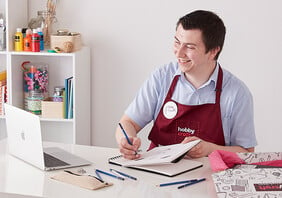Meet the Artist: Watercolour Artist Charles Evans
As well as being a regular on various TV art shows, artist Charles Evans is one of Windsor and Newton's top demonstrators and demonstrates all over the country. He also writes for art magazines, holds stage shows, workshops and runs painting holidays in the UK and Europe.
Successful watercolour artist Charles Evans tells us why his passion for painting is all-encompassing.
You will need
'Born and bred as a country boy in 1953 in the then West Riding of Yorkshire, I had the privilege of a childhood spent playing in the fields and woods, rivers and lakesides around the farm where I grew up. This fuelled an already inbred appreciation of the countryside and at an early age, my heroes were Turner, Flint and Constable.
At a very early age, my heroes were Turner, Flint and Constable.
'I studied at Lincoln College of Art but in the mid-seventies there was no living to be made out of art, so I turned my attention to a career in catering. While still working in that trade, I was commissioned by the National Coal Board to paint a series of watercolour paintings of pits and pit villages, which led to a very long and fruitful alliance. The Coal Board also sponsored my first one-man exhibition in 1983.

'In 1983 I was commissioned by Yorkshire Television to paint a moorland scene for their TV soap Emmerdale. After this I was asked by Tyne and Tees Television to do a short series of painting programmes for their regional series. These were so successful we made 96 in total, which are still being shown around the world today. I get feedback from places like Portugal, the Netherlands and even Australia!
'My style is classical landscape and I tend to work in both watercolour and acrylics. I'll use acrylics for very detailed paintings while watercolour is great for classical English landscapes, particularly in the spring when it's perfect for capturing the haziness and atmosphere of a warm day. It allows you to sum up heat and warmth in a way that's not possible in other mediums.

Use watercolours for your background and then acrylic for the detailed foreground. This allows you to put light colours on top of dark, for example, giving you more freedom.
'For beginners it can be a good idea to mix mediums. use watercolour for your background and then acrylic for the detailed foreground. This allows you to put light colours on top of dark, for example, giving you more freedom. A lot of people wait until retirement to take up painting but I always encourage everyone to start earlier. Even if they have busy lives it's worth finding the time – there's no better stress buster than painting.

'It really focuses the mind and relieves stress and pressure. painting is my life and I paint as many as 30 paintings a week, every week of the year. If I didn't make a living out of it I'd still want to paint everyday of the week. I'm totally passionate about it.'
Top Tips
- Start big – People worry about painting big but painting small actually makes things more difficult. Use a big piece of paper and throw the paint on with abandon. A landscape is a big, free, open thing so don't make it stiff, tired and lifeless with a fiddly drawing.
- Treat a landscape like a good book, with a beginning a middle and an end – You need a nice foreground,a middle and an end, going out into the distance. include something that makes the eye go through the painting, like a path, trees or tall grasses, to give it depth.
- My essential kit is just four Windsor and Newton brushes and eight tubes of paint – Keep your kit simple. Using too many colours means you end up making just a very sludgy mud colour normally!
- Don't paint flat – Maker sure your painting is tilted so the water runs down the paper rather than pooling on it.








